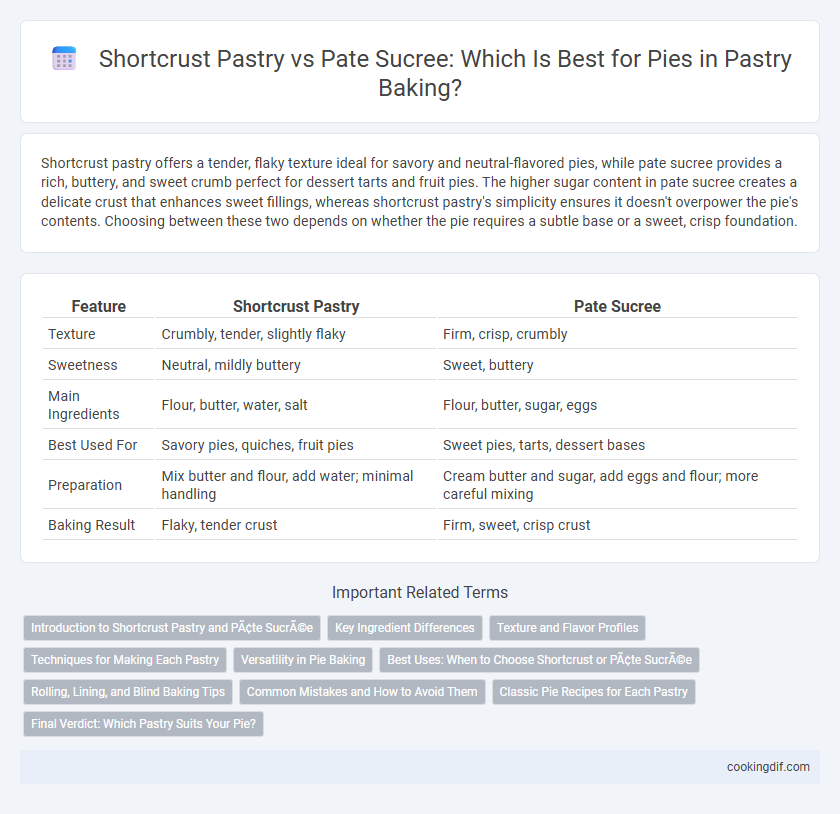Shortcrust pastry offers a tender, flaky texture ideal for savory and neutral-flavored pies, while pate sucree provides a rich, buttery, and sweet crumb perfect for dessert tarts and fruit pies. The higher sugar content in pate sucree creates a delicate crust that enhances sweet fillings, whereas shortcrust pastry's simplicity ensures it doesn't overpower the pie's contents. Choosing between these two depends on whether the pie requires a subtle base or a sweet, crisp foundation.
Table of Comparison
| Feature | Shortcrust Pastry | Pate Sucree |
|---|---|---|
| Texture | Crumbly, tender, slightly flaky | Firm, crisp, crumbly |
| Sweetness | Neutral, mildly buttery | Sweet, buttery |
| Main Ingredients | Flour, butter, water, salt | Flour, butter, sugar, eggs |
| Best Used For | Savory pies, quiches, fruit pies | Sweet pies, tarts, dessert bases |
| Preparation | Mix butter and flour, add water; minimal handling | Cream butter and sugar, add eggs and flour; more careful mixing |
| Baking Result | Flaky, tender crust | Firm, sweet, crisp crust |
Introduction to Shortcrust Pastry and Pâte Sucrée
Shortcrust pastry is a classic dough known for its tender and flaky texture, commonly used for savory and sweet pies. Pate sucree, a French sweet pastry, contains more sugar and butter, resulting in a crumbly, cookie-like crust ideal for delicate tart shells. Both doughs balance fat, flour, and liquid differently to achieve unique textures that complement various pie fillings.
Key Ingredient Differences
Shortcrust pastry typically contains a higher ratio of flour to fat, using cold butter and just enough water to bind the dough, resulting in a tender, flaky texture ideal for savory or neutral-flavored pies. Pate sucree incorporates sugar and egg yolks alongside butter and flour, creating a richer, sweeter dough with a crumbly, cookie-like consistency best suited for dessert tarts and sweet pies. The presence of eggs and sugar in pate sucree enhances browning and flavor, distinguishing it significantly from the simpler, less sweet shortcrust pastry.
Texture and Flavor Profiles
Shortcrust pastry offers a tender, crumbly texture with a neutral buttery flavor, making it ideal for both savory and sweet pies. Pate sucree features a firmer, crumbly texture with a pronounced sweetness and rich buttery notes, enhancing dessert pies with a delicate, cookie-like finish. The choice between shortcrust and pate sucree depends on whether a subtle or distinctly sweet base is desired for pie crusts.
Techniques for Making Each Pastry
Shortcrust pastry requires gently rubbing cold butter into flour until the mixture resembles breadcrumbs, then adding cold water gradually to form a dough that is rested before rolling out to ensure a tender crust. Pate sucree calls for creaming softened butter and sugar together before incorporating eggs and sifted flour, creating a richer, sweeter dough that benefits from chilling to prevent shrinkage and cracking during baking. Mastering the temperature control and mixing techniques in each dough ensures optimal texture and flavor for perfect pie bases.
Versatility in Pie Baking
Shortcrust pastry offers exceptional versatility in pie baking due to its tender, flaky texture and neutral flavor, making it ideal for both sweet and savory pies. Pate sucree, with its rich, buttery sweetness and crumbly consistency, is specifically tailored for sweet pies and tarts, providing a delicate contrast to fruity or creamy fillings. Bakers often choose shortcrust pastry for all-purpose recipes, while pate sucree is preferred when a refined, dessert-focused crust enhances the overall flavor profile.
Best Uses: When to Choose Shortcrust or Pâte Sucrée
Shortcrust pastry is ideal for savory dishes and pies requiring a tender, flaky texture without added sweetness. Pate sucree, with its sweet, crumbly consistency, is best suited for dessert tarts and fruit pies where a richer flavor complements the filling. Choose shortcrust for quiches or meat pies, while pate sucree enhances custard tarts and delicate fruit desserts.
Rolling, Lining, and Blind Baking Tips
Shortcrust pastry offers easier rolling and shaping due to its balanced fat content, making it less likely to crack compared to pate sucree, which tends to be more delicate and prone to breaking. When lining pie tins, pressing shortcrust pastry evenly ensures a sturdy base, while pate sucree requires gentle handling to maintain its crumbly texture without overworking. For blind baking, docking shortcrust prevents puffing, and using pie weights or dried beans helps maintain shape; pate sucree benefits from a shorter blind bake to preserve its buttery crispness without drying out.
Common Mistakes and How to Avoid Them
Shortcrust pastry often becomes tough due to overworking the dough, while pate sucree can turn overly crumbly if not baked at the correct temperature. Avoid these mistakes by handling shortcrust pastry minimally and chilling it before rolling out, ensuring a tender, flaky crust. For pate sucree, maintain precise oven temperatures between 325degF to 350degF (160degC to 175degC) to achieve a firm yet delicate crumb without burning.
Classic Pie Recipes for Each Pastry
Shortcrust pastry serves as the ideal base for classic savory pies like quiche Lorraine and steak and kidney pie, offering a flaky, buttery texture that complements rich fillings. Pate sucree, a sweetened shortcrust variant, excels in traditional French dessert pies such as tarte aux pommes and tarte au citron, providing a tender, crumbly crust that balances sugary, fruit-based fillings. Choosing between these two depends on the desired sweetness and texture, with shortcrust enhancing savory dishes and pate sucree perfecting delicate, sweet pastries.
Final Verdict: Which Pastry Suits Your Pie?
Shortcrust pastry offers a crumbly, buttery texture ideal for savory and fruit pies requiring sturdier support, while pate sucree provides a sweeter, more tender crust perfect for delicate dessert tarts and custard fillings. Choosing between them depends on the pie's flavor profile and desired texture; shortcrust enhances robustness, pate sucree complements sweetness with a refined finish. For fruit pies or quiches, shortcrust is preferable, whereas pate sucree best suits finely-textured, sweet tarts.
Shortcrust pastry vs pâte sucrée for pies Infographic

 cookingdif.com
cookingdif.com